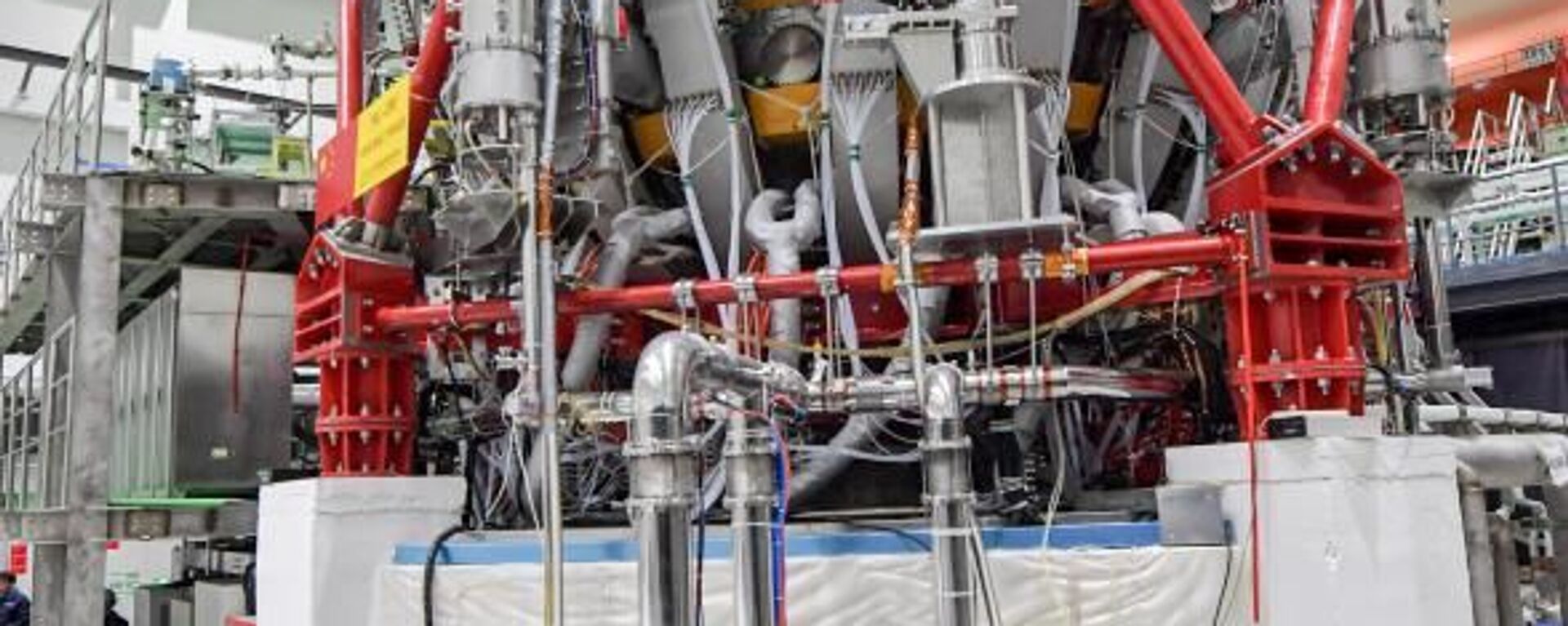Creating an Artificial Sun: Self-Sustaining Energy Received From Burning Plasma After Nuclear Fusion
02:52 GMT 28.01.2022 (Updated: 13:32 GMT 06.08.2022)

© REUTERS / DAMIEN JEMISON
Subscribe
As demand for safe and efficient energy will only continue to grow, scientists have high hopes for nuclear fusion. The idea is to copy the principle that powers stars and If numerous attempts succeed, people will receive a source of perpetual energy.
A big step towards this goal was made by an international team of researchers at the Lawrence National Laboratory in Livermore, US, part of the Energy Department, who managed to heat fusion fuel at an extreme temperature so that the plasma gave off more energy than it received.
According to the research, published in Nature, the milestone experiment demonstrated the burning plasma phenomenon that could help develop self-sustaining fusion energy.
The energy produced by the experiment was said to be modest - about the equivalent of nine nine-volt batteries, used to charge small devices, and the scientists noted that further improvements of the technology would require many years. The fusion production lasted 100 trillionths of a second.
"Fusion requires that we get the fuel incredibly hot in order for it to burn - like a regular fire, but for fusion we need about a hundred million degrees (Fahrenheit). For decades we've been able to cause fusion reactions to occur in experiments by putting a lot of heating into the fuel, but this isn't good enough to produce net energy from fusion," said Alex Zylstra, an experimental physicist at Lawrence Livermore National Laboratory and lead author of the research.
Plasma is called the fourth state of matter after solid, liquid, and gas, and can be produced in thermonuclear reactors. There are main two ways of generating net energy through fusion. The more common one is based on slow thermonuclear fusion, in which physicists contain the hot plasma using magnetic fields and electric currents.
The alternative approach is known as fast thermonuclear fusion, whereby the thermonuclear reaction proceeds in millionths of a second. The process requires powerful lasers that compress thermonuclear fuel, made of tritium and deuterium, two hydrogen isotopes. This technology is being actively developed at the US National Ignition Facility (NIF) experimental reactor.
In Nature this week: The heat is on – Burning plasma marks key step towards power from nuclear fusion. Browse the full issue: https://t.co/eR1KDzin4I pic.twitter.com/kMJjsTeIDO
— nature (@Nature) January 27, 2022
The team of researchers in Lawrence National Laboratory used the most powerful laser system in the world, which has the size of three football fields. Scientists fired 192 laser beams at a microscopic capsule, filled with deuterium and tritium fusion fuel.
Physicists led by Alex Zylstra have tripled the amount of energy that NIF can generate. This was possible after researchers learned to more accurately concentrate the laser beams on nuclear fuel and interfere with their dispersion, which occurs due to the interaction of light particles with gas molecules that cool the capsule.
“A Burning Plasma”
— PTV News (@PTVNewsOfficial) January 27, 2022
Video courtesy: @Reuters pic.twitter.com/OB1XTV022O
Previously, scientists tried to solve this problem by lowering the density of the gas. As a result, the capsule quickly heated up and expanded, which dramatically reduced the temperature and pressure inside the fusion fuel. Zylstra and his colleagues found that this obstacle could be overcome by installing a special photonic crystal in front of the capsule’s entrance, which would concentrate the energy of the laser beams inside.
The laser pulse brought pressure of about 100 billion bars and a temperature of 100 million degrees Celsius (at the center of the Sun, the temperature is only 15 million degrees).
“If you want to make a campfire, you want to get the fire hot enough that the wood can keep itself burning,” said Zylstra. “This is a good analogy for a burning plasma, where the fusion is now starting to become self-sustaining.”
High pressure and temperature lead to the fusion of helium nuclei from deuterium and tritium nuclei. At which point, a thermonuclear reaction begins, accompanied by the release of huge amounts of energy. The process is the same as the one that sustains energy in stars.
"Now, for the first time, fusion reactions occurring in the fuel provided most of the heating - so fusion is starting to dominate over the heating we did. This is a new regime called a burning plasma," Zylstra said.
The scientists also found that the efficiency of thermonuclear reactions can be further increased by using a capsule that is not in the form of a barrel, but rather a dumbbell. By doing so, physicists have dramatically reduced the likelihood that laser beams will scatter in the wrong way when interacting with gas molecules that cool the walls of a fusion fuel capsule.

China's 'Artificial Sun' Could Generate Electricity in a Decade in Race to Harness Fusion Technology
30 September 2021, 14:57 GMT
The modifications helped scientists triple the efficiency of fast thermonuclear fusion. According to Zylstra and his colleagues, this approach is still very far from being a stable and reliable source of thermonuclear fusion energy, but scientists expect that subsequent improvements in laser beam focusing technology will help them come closer to reaching that goal.
"Making fusion a reality is an enormously complex technological challenge, and it will require serious investment and innovation to make it practical and economical," he said. "I view fusion as a decadal-scale challenge for it to be a viable source of energy."
